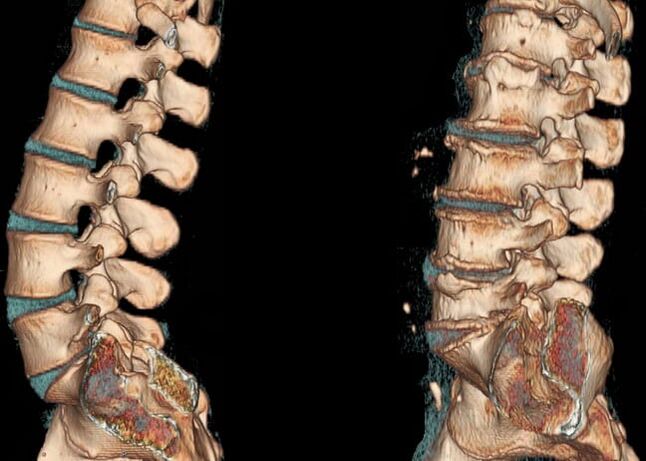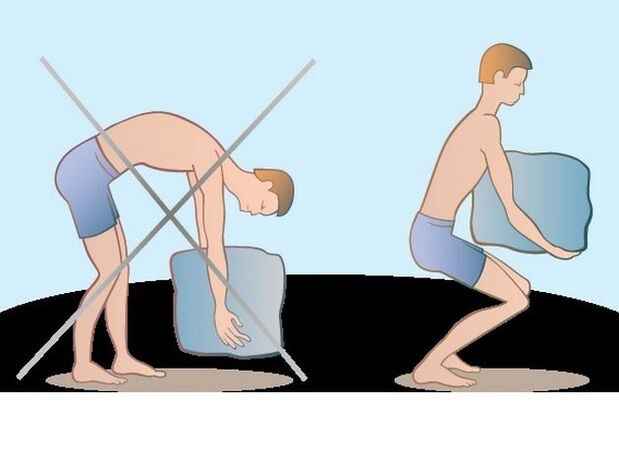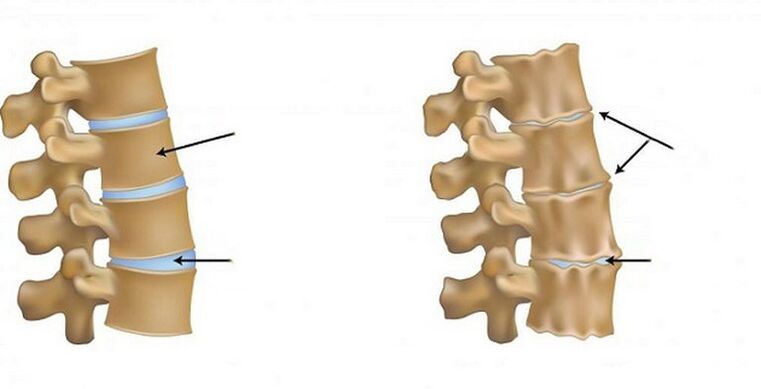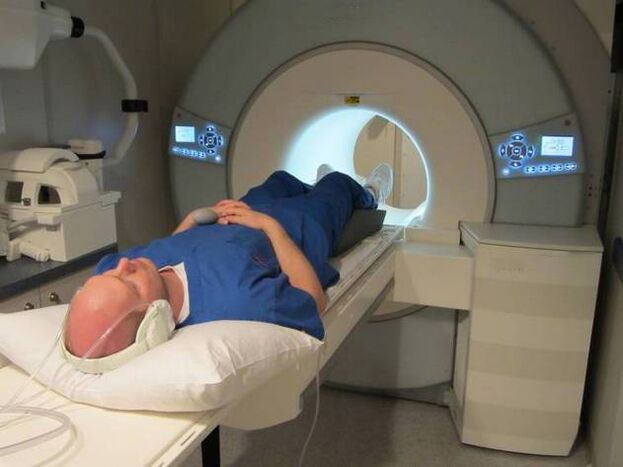
People with lumbar spinal osteochondrosis always avoid movements -are cautious, leaning and turning to the side, slowly sitting, waking up.Therefore, they try to avoid sharp, piercing back pain, forcing them to freeze in one body position.Osteochondrosis is also indicated by problems, clicks, mobility limitations.The treatment is more conservative, but with severe damage to the disc and vertebra, surgical intervention is required.
What is lumbar spinal osteochondrosis
Lumbar osteochondrosis is a degenerative-dystrophic pathology, which initially affects the intervertebral disc.Due to inadequate nutrient intake, they lose the ability to maintain moisture.The process of regeneration is slow, the disc becomes flat, fragile.The distance between adjacent vertebrae is reduced, therefore, bone tissue grows to stabilize the lumbar segment affected by osteochondrosis.Osteophytes are formed - bone growth, with a displacement of soft tissue structures, nerve roots, blood vessels injured.
The pathological stage
The level of osteochondrosis is the stage of the development of the disease, characterized by certain damaging changes in the disk and body of the vertebra.It was established using the X -ray exam.Regarding the image produced, the signs of the destruction of the vertebral structure are clearly visible.Each stage corresponds to the severity of osteochondrosis, a set of symptoms.The higher, the more difficult the disease lends itself to conservative treatment.
| Lumbar osteochondrosis level | Features -Remember X -ray and clinical manifestations |
| First (premature) | There are no signs of osteochondrosis on radiography.Sometimes there is an uncomfortable sensation on the lower back after a physical hard work or long stay on the foot |
| The second | There is correction of lordosis, less frequently -body scenes -vertebral body, semi -moon process deformation.The height of the disc is slightly reduced.Painful sensations appear to be more frequent, their period increases |
| The third | Sclerosis of the cover plate subcondral, damage to a large number of partial -moon processes, and a moderate decrease in disc height is observed.In addition to pain in the lumbar region, the clinic contains problems, stiffness of movement |
| Fourth | The semi -moon process is rejected outside and posteriorly.There is growth of bone tissue compensation, the formation of various osteophytes.Pain occurs while moving and resting |
Cause

The cause of the development of osteochondrosis often increases the burden on the lumbar spine.The disc is always microtrauma, not having time to recover timely.Most gradually damaged, launching the body's body deformation.Such pathological conditions can also cause the destruction of the lumbar segment:
- congenital or anomalies obtained - flat feet, scoliosis, kyphosis, deformation of foot valgus, TBS displacement;
- Systemic pathology - rheumatoid arthritis, scleroderma, red lupus;
- endocrine and metabolic disease, diabetes mellitus, hypo- and hyperthyroidism, obesity;
- Previous injuries - vertebral subluxation and their bone fractures, damage to the spinal cord;
- Blood circulation disorders, including against the background of inactive lifestyle.
One of the main causes of osteochondrosis is the natural aging of the body.After 50 years, the recovery process slows down, collagen production decreases, ligaments worsen.
Signs and symptoms of disease
In the early stages of development, osteochondrosis did not appear clinically.One takes weak pain in the lower back to overvoltage muscle after working day and does not consult a doctor.But the severity of the symptoms is slow - the problem is increasing - soon problems with tilt and case change, sensitivity disorders, and stiffness are unified.
Rook Syndrome
This is the name of the spinal cord defeat, leading to motor, vegetative and severe disorders.Rotor syndrome develops with 3-4 severity osteochondrosis.At this stage, intervertebral hernia is formed, compressing the spinal cord.The pathology is continued according to the types of lumbago, lumbalgia and lumbar -ilgia.In addition to severe pain, radicular syndrome is characterized by numbness, tingling, goosebumps crawling, decreasing or incomplete sensitivity.
Ischemic syndrome

In the final stages of lumbar osteochondrosis, it is possible to compress the large blood vessel herniacating.The pelvic organs stop receiving sufficient amounts of nutrients, leading to a violation of their function.Cerebral cerebral trophy is also disappointed, neurological deficiency develops - instantaneous deficiency - appears, temperature, fall sensitivity.
Vertebrate syndrome
As a result of reducing the distance between the bodies next to the vertebrae, the growth of the bone tissue, the lumbar vertebral segment is gradually defective.This condition is aggravated by the constant compensation of the back muscles with the next atrophy.Pathology changes a person's style and posture, including due to improper distribution of loads.The likelihood of involving other parts of the spine and the joints in a process that damages it is significantly increased.
The sick syndrome
In the lower back is a large sciatic nerve formed by the sacred spine.When it is violated with hernial highlights, bone growth, spasmodic muscles, ishias occur - a typical symptom of lumbar osteochondrosis.There is acute pain spreading along the sciatic nerves to the hips, knees, lower legs (lumbar -ilgia).Another specific pathological feature - lumbago, or "shot" in the lower back after a sharp tendency or turn, hypothermia.
Diagnostic method

When making a diagnosis, radiographic images taken in two projections are most informative.To study the more detailed lumbar segment, MRI was performed.This study allows you to assess the state of the spinal cord, soft tissue structure, blood vessels, nerve roots.It is possible to determine the degree of damage to the nerve stem using potential, electronography, electromilography caused.To target the affected disk inspection, a discography is used.
How's the treatment run
A comprehensive approach to therapy for lumbar osteochondrosis is practiced.The treatment is intended to eliminate pain, restore the amount of movement, prevent the spread of pathology to a healthy disc and vertebra.
Drug
The use of anti -anti -non -sorting drugs, glucocorticosteroids, muscle relaxants allows you to get rid of lower back pain.In therapy, medicines are used to improve blood circulation.Patients must be prescribed vitamin B group, chondroprotectors.
Physical Education Medicine
This is the most effective and affordable treatment for osteochondrosis.After 1-2 months of daily treatment of physiotherapy exercises, the muscles not only the lower back, but the whole back, increasing posture, accelerating blood supply to the damaged tissue structure.The LFK doctor recommends that the patient recommends a slow turn and Tilts Torso, shallow squats and lunges.
Massage
Patients with lumbar osteochondrosis show all types of massage - vacuum, acupuncture, connectors, segments.But the most in demand is classic.During the session, the massage therapist performs the main massage movement: rubbing, rubbing, kneading, vibration.The goal of the procedure is to eliminate muscle cramps, improve blood circulation in the affected segment, and strengthen the skeletal muscles.
Physiotherapy
During acute and subacute periods, patients are prescribed by electrophoresis or ultrafonofhoresis with glucocorticosteroids, anesthetics, vitamin B. At remission stages, laser therapy, magnetotherapy, stressful wave therapy, and UHF therapy are often performed.Ozokeritoling, paraffin applications, hirudotherapy, mud, radon, hydrogen sulfide baths are also used.
Surgical intervention
The main indication for surgical intervention is the spinal cord infringement with hernial highlights.During operation, intervertebral hernia is removed, compression of the spinal cord.The most commonly used surgical intervention methods for lumbar osteochondrosis are microdiscectomy, puncture or laser reconstruction, implant installation, vertebral segment stabilization.
Traditional medicine
After the main therapy, stable remission achievement in treatment, home -made ointment, herbal tea, compression, oil and alcohol is used.People's recovery does not affect the cause of osteochondrosis, so they are used to eliminate poor pain, pain, lower severity after hypothermia, sharp changes in weather or increased physical activity.
As a result of the lack of treatment
The development of almost all complications of lumbar osteochondrosis is provoked by the intervertebral hernia formed.Discogenic myelopathy is very dangerous, which does not always change despite surgical treatment.It is characterized by pelvic disorders, including water disorders, urine.Complications of osteochondrosis also include rooser syndrome - a common cause of acute, lower back pain.
Prevention and forecast measures
This prognosis is profitable in the pathological diagnosis of 1-2 degrees of severity.It lends itself well to conservative treatment, and in young patients, it is also possible to restore intervertebral disc tissue.With the development of complications, predictions for full recovery are poor.
Prevention of lumbar spinal osteochondrosis is to control weight, exception of excess load, endocrine treatment, timely metabolic disease.Neurologists and vertebrologists recommend visiting the pool, involved in Aquaerobics, Pilates, Scandinavian Walking.



















